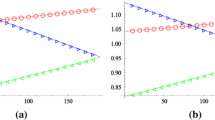Abstract
Recent literature on optimal investment has stressed the difference between the impact of risk and the impact of ambiguity—also called Knightian uncertainty—on investors’ decisions. In this paper, we show that a decision maker’s attitude towards ambiguity is similarly crucial for investment decisions. We capture the investor’s individual ambiguity attitude by applying α-MEU preferences to a standard investment problem. We show that the presence of ambiguity often leads to an increase in the subjective project value, and entrepreneurs are more eager to invest. Thereby, our investment model helps to explain differences in investment behavior in situations which are objectively identical.
Similar content being viewed by others
References
Ahn, D., Choi, S., Gale, D., Kariv, S.: Estimating ambiguity aversion in a portfolio choice experiment. UC Berkeley Working Paper (2007)
Al-Najjar N.I., Weinstein J.: The ambiguity aversion literature: a critical assessment. Econ. Philos. 25, 249–284 (2009)
Asano, T.: Irreversibilities and the optimal timing of environmental policy under knightian uncertainty. Discussion paper No. 643, Institute of Social and Economic Research at Osaka University (2005)
Bhidé A.V.: The Origin and Evolution of New Business. Oxford University Press, Oxford (2000)
Chateauneuf A., Eichberger J., Grant S.: Choice under uncertainty with the best and worst in mind: neo-additive capacities. J. Econ. Theory 137, 538–567 (2007)
Chen Z., Epstein L.: Ambiguity, risk, and asset returns in continuous time. Econometrica 70(4), 1403–1443 (2002)
Choi, U.J., Kim, K., Kwak, M.: Investment under ambiguity and regime-switching environment. Working paper, Korea Advanced Institute of Science and Technology (KAIST) (2009)
DeBondt, W.F., Thaler, R.H.: Financial decision-making in markets and firms: a behavioral perspective. In: Handbook in Operations Research and Management Science: Finance, pp. 385–410. Elsevier, Amsterdam (1995)
Dixit A.K., Pindyck R.S.: Investment Under Uncertainty. Princeton University Press, Princeton (1994)
Duffie D.: Dynamic Asset Pricing Theory, 3rd edn. Princeton University Press, Princeton (2001)
Economist: The R-Word. The Econ. 359(8216), 106 (2001)
Ellsberg D.: Risk, ambiguity and the savage axioms. Quart. J. Econ. 75(4), 643–669 (1961)
Epstein L.G., Schneider M.: IID: independently and indistinguishable distributed. J. Econ. Theory 113(1), 32–50 (2003a)
Epstein L.G., Schneider M.: Recursive multiple-priors. J. Econ. Theory 113(1), 1–31 (2003b)
Epstein L.G., Schneider M.: Ambiguity, information quality and asset pricing. J. Finance 63(1), 197–228 (2008)
Epstein L.G., Wang T.: Intertemporal asset pricing under knightian uncertainty. Econometrica 62(3), 283–322 (1994)
Ghiradato P., Maccheroni F., Marinacci M.: Differentiating ambiguity and ambiguity attitude. J. Econ. Theory 118, 133–173 (2004)
Gilboa I., Schmeidler D.: Maxmin expected utility with non-unique prior. J. Math. Econ. 18, 141–153 (1989)
Gysler, M., Kruse, J.B., Schubert, R.: Ambiguity and gender differences in financial decision making: an experimental examination of competence and confidence effects. Center for Economic Research, Swiss Federal Insitute of Technology, working paper (2002)
Hannay E., Klibanoff P.: Updating preferences with multiple priors. Theor. Econ. 2, 261–298 (2006)
Heath C., Tversky A.: Preference and belief: ambiguity and competence in choice under uncertainty. J. Risk Uncertain. 4(1), 5–28 (1991)
Hurwicz, L.: Optimality criteria for decision making under ignorance. Cowles Communication Discussion Paper, Statistics No. 370 (1951)
Karatzas I., Kou S.G.: Hedging american contigent claims with constraint portfolios. Finance Stoch. 2, 215–258 (1998)
Kilka M., Weber M.: What determines the shape of the probability weighting function under uncertainty?. Manage. Sci. 47, 1712–1726 (1998)
Klibanoff P., Marinacci M., Mukerji S.: A smooth model of decision making under ambiguity. Econometrica 73(6), 1849–1892 (2005)
Klibanoff P., Marinacci M., Mukerji S.: Recursive smooth ambiguity preferences. J. Econ. Theory 144(3), 930–976 (2009)
Knight F.H.: Risk, Uncertainty, and Profit. Houghton Mifflin Company, Boston, MA (1921)
Kopylov, I.: Subjective probability and confidence. Working paper University of California, Irvine, (2008)
Marinacci M.: Probabilistic sophistication and multiple priors. Econometrica 70(2), 755–764 (2002)
McDonald R., Siegel D.: The value of waiting to invest. Quart. J. Econ. 101(4), 707–728 (1986)
Miao, J., Wang, N.: Risk, uncertainty, and option exercise. Working paper Boston University and Columbia Business School (2007)
Nishimura K.G., Ozaki H.: An axiomatic approach to \({\epsilon}\)-contamination. Econ. Theory 27, 333–340 (2004a)
Nishimura K.G., Ozaki H.: Search and knightian uncertainty. J. Econ. Theory 119(2), 299–333 (2004b)
Nishimura K.G., Ozaki H.: Irreversible investment and knightian uncertainty. J. Econ. Theory 136(1), 668–694 (2007)
Olszewski W.: Preferences over sets of lotteries. Rev. Econ. Stud. 74, 567–595 (2007)
Riedel F.: Optimal stopping with multiple priors. Econometrica 77(3), 857–908 (2009)
Roubaud, D., Lapied, A., Kast, R.: Real options under ambiguity. working paper (2010)
Sarin R., Wakker P.: Dynamic choice and non expected utility. J. Risk Uncertain. 17, 87–119 (1998)
Savage L.J.: The Foundations of Statistics. Wiley, New York (1954)
Schmeidler D.: Subjective probability and expected utility without additivity. Econometrica 57(3), 571–587 (1989)
Skiadas, C.: Smooth ambiguity aversion towards small risks and continuous-time recursive utility. Working paper (2008)
Trojanowska M., Kort P.M.: The worst case for real options. J. Optim. Theory Appl. 146(3), 709–734 (2010)
Author information
Authors and Affiliations
Corresponding author
Rights and permissions
About this article
Cite this article
Schröder, D. Investment under ambiguity with the best and worst in mind. Math Finan Econ 4, 107–133 (2011). https://doi.org/10.1007/s11579-011-0036-3
Received:
Accepted:
Published:
Issue Date:
DOI: https://doi.org/10.1007/s11579-011-0036-3
Keywords
- Investment decision
- Ambiguity
- Knightian uncertainty
- Ambiguity aversion
- Optimism
- Pessimism
- Real option
- Dynamic consistency
- α-MEU preferences




